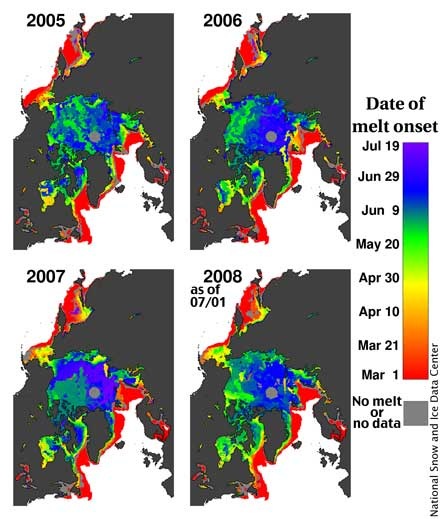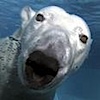 The National Snow & Ice Data Centre in the US is issuing regular (monthly, though they might have to become more frequent soon) updates on the progress of this year’s Arctic melt season. Today they released their report for June, and like their earlier reports (accessed from the drop down menu top right on the page), it includes a lot of very interesting reading. Here’s a highlight:
The National Snow & Ice Data Centre in the US is issuing regular (monthly, though they might have to become more frequent soon) updates on the progress of this year’s Arctic melt season. Today they released their report for June, and like their earlier reports (accessed from the drop down menu top right on the page), it includes a lot of very interesting reading. Here’s a highlight:
June sea ice extents in 2008 and 2007 are essentially identical, and near the lowest values for June ever recorded by satellite for the Arctic.
They note that the spatial pattern of melt this year is very different to last year, with much less melting in the Chuckchi Sea (top left on the pic at top – click for a bigger version), and much more to the north of Greenland and the Canadian archipelago. But the big news is that this year’s melt season started much earlier than usual. Take a look at this graphic:
The blue bits show the areas that start melting latest. 2007 was close to the long term average in that respect, and the difference with this year is striking:
This year, sea ice in the Beaufort Sea began to melt on average 15 days earlier than normal, and 15 days earlier than last year. Surface melt in the Chukchi and East Siberian seas was 6 days earlier than normal, and 14 days earlier than in 2007. In the central Arctic Ocean, melt began around June 9th, which was 12 days earlier than normal and 9 days earlier than the year before.
Even the areas where the ice still looks pretty solid (north of Siberia) started melting weeks ahead of normal. The next month is going to be extremely interesting. The odds are tipping my way again…
Note: my new favourite site for monitoring the current sea ice area is the University of Bremen’s imagery. I don’t mean to be disloyal to Cryosphere Today, which remains essential, but Bremen’s images are higher resolution, and to my eye make what’s going on easier to follow. If we could just get some of CT’s features at Bremen, and vice versa… 😉
[This post updated July 4 to reflect amended NSIDC graphic and text (see comments). Doesn’t look as bad as it did – but that’s not much cause for comfort.]




 A bit more on wind, and some worthwhile weekend reading. The British government has announced that it is planning a huge expansion in the use of wind power, building up to 7,000 turbines at a cost of up to £10bn, and expects renewable energy to account for 15% of all energy use by 2020. The BBC reports the somewhat
A bit more on wind, and some worthwhile weekend reading. The British government has announced that it is planning a huge expansion in the use of wind power, building up to 7,000 turbines at a cost of up to £10bn, and expects renewable energy to account for 15% of all energy use by 2020. The BBC reports the somewhat